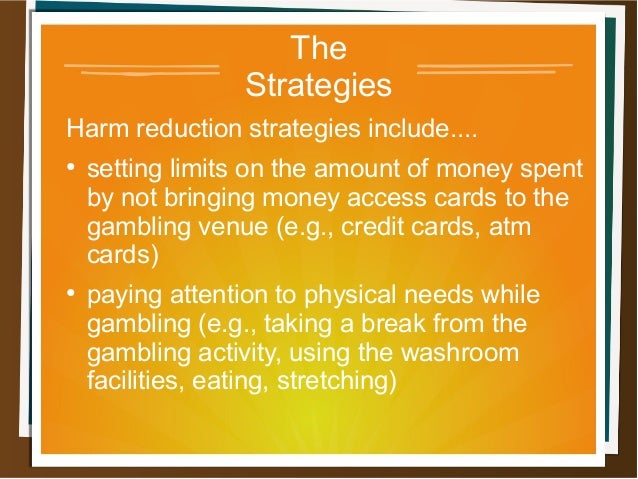Harm Reduction Strategies For Gambling
- Harm Reduction Strategies For Gambling Devices
- Harm Reduction Strategies For Gambling Disorder
- Harm Reduction Strategies For Gambling
Given that gambling is clearly a public health issue, a similar framework should be developed in line with the independent knowledge base of gambling harm, and consistent with public health advocacy strategies. 35, 64, 77 This would provide an avenue for gambling harm to be recognised as both a societal and a global problem. Reducing the exposure to gambling related stimuli, particularly to young people who may attend a gambling establishment’s bistro, family area, function room, play area or court yard is a key harm prevention strategy of this Policy. 4 Council will require evidence of intentional design of any new or redeveloped gambling establishment. The only way to remove the risk completely is not to gamble at all. However, if you choose to gamble, there are ways that you can lower the risk. Consider the following steps to keep your gambling safe. Set limits on the amount of money and time spent gambling.
When you talk about drug and alcohol addiction treatment, there tends to be two very distinct branches. The first is the old school approach. It includes abstinence, zero tolerance, and 12 step meetings. The second approach is newer, and tends to be surrounded in controversy. It includes harm reduction and sometimes has some sort of involvement with medication assisted treatment.
Harm Reduction Strategies For Gambling Devices
The idea of harm reduction is often misunderstood and criticized as an “easy out” for addicts, but that’s not the case. Here, the theories behind the addiction philosophy are detailed, as well as the benefits a harm reduction approach can have, both on the addict or alcoholic and the community as a whole.
What Is Harm Reduction?
Harm reduction is the application of practical strategies that are designed to reduce the negative consequences associated with drug and alcohol abuse. It may not eliminate drug use completely and those who participate in the programs may not be 100 percent sober all the time, but the programs work and create a range of benefits for both the individual addict and the community in which he or she resides.
Harm Reduction Strategies For Gambling Disorder
Here are some examples of harm reduction programs:
Needle Exchange Programs
Designed to allow IV drug users to exchange dirty needles for clean ones, needle exchange programs have significantly lowered the prevalence of certain blood borne diseases such as HIV, AIDS, and Hepatitis C.
Methadone and Suboxone Programs
Medically Assisted Treatment (MAT) programs have sprung up across the country because they work. While not everyone will agree that those in MAT are “sober,” there is no doubt that the programs reduce mortality, both from overdoses and other causes, reduce crime rates, and increase the quality of life for both the individual and his or her family, partially if there are children involved.
LEAD Programs
Designed to allow police to intervene with addicts instead of arresting them, LEAD programs link addicts and alcoholics who are engaging in petty crimes to support their habits with social services and community programing that can help get them get their lives in order. While many of those linked don’t necessarily get in recovery, they do better their lives, stop using as much drugs, and stay out of the criminal system.
Meet Them Where They’re At
Harm Reduction Strategies For Gambling

The fundamental idea behind harm reduction programs is to meet the addicted individual where he or she is at, both in their addiction and in their desire to get sober and to keep him or her as safe as possible.
The fact is, drug use is part of the world and it always has been. No amount of laws, regulations, or punishments deter all people from using. To assume that they can is unrealistic. Instead, the harm reduction approach attempts to reduce harm, to both the individual, his or her family and friends, and to the community.